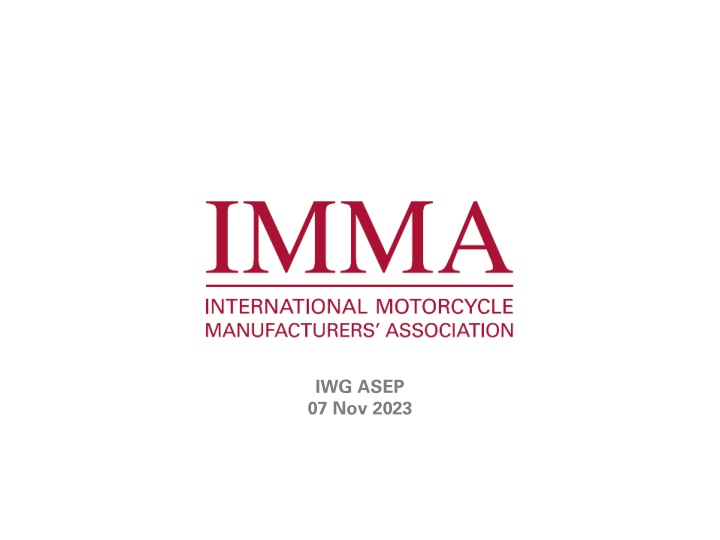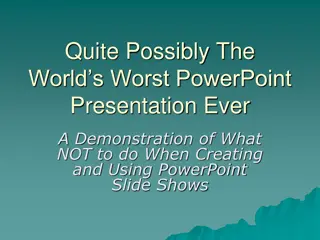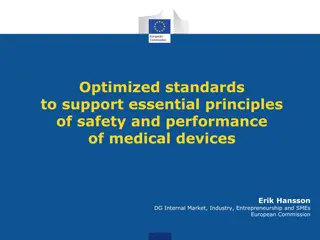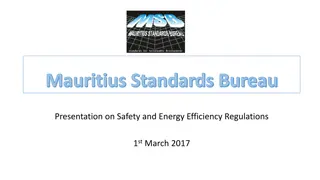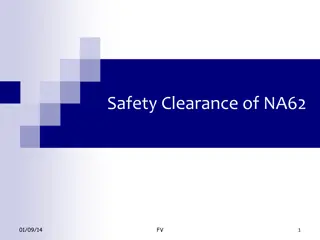Evolution of Motorcycles Safety Standards in the EU: A Historical Overview
Delve into the historical development of safety standards for motorcycles in the EU, tracing back from past initiatives to the current ASEP-16-09 protocol. Explore the progression towards dynamic limits, partial load considerations, and the transition from ASEP to RD-ASEP. Discover the challenges faced and advancements made in ensuring motorcycle safety through regulatory frameworks.
Download Presentation

Please find below an Image/Link to download the presentation.
The content on the website is provided AS IS for your information and personal use only. It may not be sold, licensed, or shared on other websites without obtaining consent from the author.If you encounter any issues during the download, it is possible that the publisher has removed the file from their server.
You are allowed to download the files provided on this website for personal or commercial use, subject to the condition that they are used lawfully. All files are the property of their respective owners.
The content on the website is provided AS IS for your information and personal use only. It may not be sold, licensed, or shared on other websites without obtaining consent from the author.
E N D
Presentation Transcript
IWG ASEP 07 Nov 2023
History: looking back 2016 GRB-64-16 (FR): Questionnaire: R51/03 needs work, R41/04 not IMMA trigger to start working on ASEP 2017 EU COM report on L-cat L_Urban limits study GRB-66-12 (DE): Grey areas of EU/UN regs ASEP-06-05: IWG ASEP requesting L-cat to consider model approach 2018 GRBP-69-13: IMMA wants quick action closing grey zones , consider model later ASEP-12-07Rev2: IMMA concept RD-ASEP 2019 GRBP-71-19Rev1 and GRBP-71-25: 2-step approach for L-cat + IMMA concept ASEP-16-09: IMMA sound expectation model considerations: GRBP/2020/9 and GRBP-72-05: RD-ASEP step 1 adopted as R41/05 2020 Difficult to apply to L-cat due to: - wide variation in tyre rolling, - CVT-DCTnot possible, - different load-depending dynamic - No correlation v * a / sound for MC - R41 specificS (PP) 2021 EU COM 2nd report on L-cat L_Urban limits study 2022 GRBP-77-27Rev1: GRBP priorities, IWG ASEP re-start in 2023 2023 2
ASEP Step 1: from R41/04 ASEP to R41/05 RD-ASEP GRBP-71-19Rev1: R41/04 ASEP R41/05 RD-ASEP Speed range 20 80 km/h 10 100km/h (for PMR 150) 3.4 * PMR-0.33 * (S nidle) +nidle Max rpm 0,8 x S (= increased) Gears tested Fixed gear (not including 1st) Any gear (including 1st) Throttle operation (between AA & BB ) WOT only Any constant throttle Approach (pre AA ) Constant speed Any approach (constant speed, acceleration, deceleration) Applicability All (PMR>50) All (PMR>50) ASEP limits Established for R41/04 based on fleet data Established for R41/04 based on fleet data 3
Partial load R51/03 supplement 7 includes dynamic limits depending on (i.e) load (Supplement 7 is in test phase until July 2024) However, due to different characteristics (exposed mechanics, less tyre noise component, different driveline, ) partial load limits has fewer benefits for Motorcycles. From ASEP-16-09 (2020): R41/04 ASEP vs. R41/05 RD-ASEP R41/05 RD-ASEP R41/04 ASEP 4
Partial load Difference between 50% load (measured) and WOT (calculated from logarithmic trendline based on WOT measurements) only vehicles without exhaust flexibilities: 52% of measured vehicles have a WOT sound level less than 2db higher than that of 50% load (average per vehicle) 78% of measured vehicles have a WOT sound level less than 3db higher than that of 50% load 3db (average per vehicle) Biggest gap is for vehicles with low max sound level: 50% load <-> WOT sound level varies depending on PMR, vehicle type, transmission type, engine type Some vehicles have a consistent gap across rpm range, some have large variations Some vehicles have 50% load sound values very similar to those for WOT = no one size fits all behavior 5
Partial load Some examples (one graph = one vehicle): Different characteristics depending on PMR, transmission type, engine type, Variations of 2~3dB possible at same Rpm from different exit Rpms/ gear 6
ASEP Step 2: Identification of potential improvements Current situation: the R41/04 and R41/05 limit line for rpm over nwot,(i) Lwot,(i)+ (5 * (nPP' nwot,(i)) / 1,000) + 3 (for nPP' nwot,(i)) is not coherent with the natural sound emission behaviour of the motorcycle: R51/03 Supplement 7: The formulas for (i.a) power train mechanic sounds acknowledges a logarithmic trend with Rpm: 7
ASEP Step 2 proposal Similar to how the R41/04 ASEP limit line was established and inspired by the principles of the sound expectation model of R51 RD-ASEP, a best fit curve was developed based on non-offending vehicle fleet data. Only vehicles without flexibilities in the exhaust were used. Current R41/05 limit The formula for nPP < nwot,(i) is unchanged min function to guarantee that new ASEP limit is at never higher than current limit New limit respecting natural sound emission behavior Special consideration for low PMR vehicles with a wide rpm band 8
ASEP Step 2 Result All vehicles are without exhaust flexibilities (one graph = one vehicle): 9
Thank you 10
